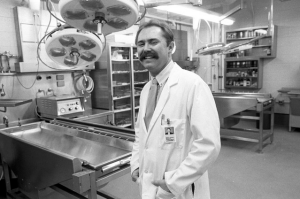|
Special Report: In warehouse of horrors,
body broker stacked human heads
 Send a link to a friend
Send a link to a friend
 [October 31, 2017]
By John Shiffman and Brian Grow [October 31, 2017]
By John Shiffman and Brian Grow
DETROIT(Reuters) - When U.S. authorities
arrested Arthur Rathburn last year, they hailed their investigation as a
milestone in efforts to police a growing industry: brokers who acquire
bodies donated to science, dissect them and sell or lease the parts for
profit.
The indictment alleges that Rathburn stored bodies destined for medical
education and training in grisly conditions and dismembered them with a
chainsaw. He is accused of endangering clients, mostly health care
workers, by renting them cadavers and severed heads that were infected
with HIV and hepatitis.
A government news release touted the arrest as “a significant step,” one
that demonstrates that protecting the public is “a high priority.”
But authorities missed repeated opportunities to rein in Rathburn,
Reuters found. Warning signs about his activities date back more than a
dozen years.

In the mid-2000s, for example, New York state health inspectors twice
reprimanded him for failure to provide documentation that bodies he
acquired were in fact willingly donated. Rathburn also had been on the
radar of federal authorities since 2010, when border agents first
questioned him about 10 heads he was transporting from Canada, court
records show.
Over the next three years, agents documented five similar cross-border
shipments, one that included a severed penis. But agents did not raid
Rathburn’s warehouse until December 2013. In the meantime, he acquired,
sold and rented out more bodies and parts.
The failure to intervene sooner shows how easily brokers can evade
government scrutiny and points to a gap in U.S. law surrounding the body
trade, an industry that typically targets the poor with incentives such
as free cremation. Rathburn and his then-wife were charged with
defrauding customers, not with selling or desecrating human remains.
Selling or leasing body parts is not a federal crime and is largely
unrestricted in all but a few states.
“The FBI told me they found my sister’s shoulder” inside Rathburn’s
warehouse, said Carol Keenan. Her sibling had donated her body in 2013,
hoping to aid cancer researchers.
“It was hard enough to lose her, but this has been devastating,” Keenan
said. “I was shocked when I learned there’s no regulation – that any
Joe-fly-by-night can start up a company and nobody knows what he’s
doing.”

Rathburn, 63, faces trial in January on charges of defrauding health
care workers and lying to federal agents. He has pleaded not guilty and
remains jailed. His ex-wife, Elizabeth Rathburn, pleaded guilty to one
count of fraud and is cooperating with prosecutors. Neither the
Rathburns nor their attorneys responded to requests for comment for this
story. The FBI also declined to comment.
CALLS FOR PROTECTION
A chance to establish national standards governing body brokers came in
2004, after disturbing reports emerged about the nascent industry.
In one case, police arrested a California university employee for
secretly selling donated cadavers. In another, the U.S. Army admitted
that bodies originally donated to a university for educational purposes
were used in landmine experiments. Harper’s Magazine also published a
10-page exposé on body brokers, briefly citing Rathburn as a supplier.
Appalled by the reports, a federal health advisory panel meeting that
year called for regulation of body brokers. The panel asked the U.S.
government to apply the same strict oversight to the body parts trade
that already governed organ transplantation.
Nothing came of the panel’s recommendation.
Since that failed effort, the market for body parts has grown, and
abuses abound, some reminiscent of those the 2004 federal panel sought
to prevent. A Reuters review of court, police and internal broker
records and interviews identified more than 2,357 body parts obtained by
brokers from at least 1,638 people that were misused, abused or
desecrated.

The customers include the U.S. government. As Reuters reported in
December, the Army used heads, arms and legs from more than 20 bodies in
blast experiments in 2012 and 2013, even though donors had not given
permission. In one of the most egregious examples, the military used the
body of an Army veteran who signed a donor form two months before he
died of cancer in 2013. The man was so angry about the poor health care
provided by the U.S. Department of Veterans Affairs that he checked “No”
to military experimentation on the consent form. It didn't matter. His
body was used in a violent Army test anyway.
An Army spokeswoman said the military was deceived by its supplier and
never “knowingly used the bodies of donors against their wishes.”
Asked about the federal panel’s 2004 call to regulate body brokers, a
U.S. Health & Human Services Department spokesman said the agency was
under “no obligation” to accept the recommendation. How and whether to
police the industry, spokesman Martin Kramer added, is left to each
state.
Most states, including Michigan, don’t regulate body brokers closely, or
at all. In those states, a broker may legally sell a donated cadaver or
its parts, such as heads and arms, so long as the remains are not
intended for transplantation. Only 10 states provide any oversight. Just
a handful require licensing or disclosure.
As a result, donors and their families are left to rely on the good
faith of the people who run the programs, said retired anatomy professor
William Burkel, who supervised Rathburn at the University of Michigan
when they both worked there in the 1980s.
“Because the laws vary so much from state to state,” Burkel said, “there
is a lot of opportunity for people like Mr. Rathburn to do it without
any sort of oversight.”

Rathburn’s alleged victims included not only donors and their families
but also the doctors, dentists and other health care workers who
acquired parts from him.
Steve Schomisch, who directs surgical training at Case Western Reserve
School of Medicine in Cleveland, learned recently how unregulated the
industry can be. Federal authorities told him that a head Rathburn
supplied to train Case Western neurosurgeons in 2013 was among a number
of body parts that could not be traced to a donor, raising questions
about the donation’s legitimacy.
“We felt betrayed,” Schomisch said. “Then we said, ‘What can we do to
make sure this doesn’t happen again?’”
Schomisch formed a university committee to research the way the industry
supplies body parts; the panel found little oversight and few rules.
Today, Case Western leases only from a handful of pre-screened brokers
that follow standards established by the American Association of Tissue
Banks, a national accrediting organization.
“It’s such a difficult decision whether to donate,” Schomisch said of
people who bequeath their bodies. “I think you just assume that by
donating, you’re doing something good. But people like Art Rathburn
tarnish that.”
“A CHARISMA ABOUT HIM”
Rathburn was hired in 1984 by the University of Michigan body donation
program, which uses cadavers for anatomy classes and research. He was 30
years old with a community college degree and a work ethic that endeared
him to better-educated colleagues.
“He had a charisma about him,” said former supervisor Stuart Baggaley.
Rathburn arrived at a critical time. University archives show that
Rathburn helped the program rebound from complaints by donor families
about poor customer service.
“He was just energetic, doing something all of the time,” said Burkel,
who led the program during those years. “He had a lot of ideas.”
One merited publication in a scientific journal and a patent: “A
State-of-the-Art Embalming and Autopsy Station,” a device that promised
safer and easier preparation of dead bodies.

In 1988, Rathburn was prominently featured in the monthly Ann Arbor
Observer newspaper. He expounded on the significance of cadavers in the
classroom and told a whimsical tale about his entry into the business –
a friend bet him $10 he wouldn’t fill out a funeral home job
application. He did. In a photograph accompanying the story, Rathburn
wears a tie, lab coat and broad smile.
Two years later, however, Rathburn left the school, records show,
following unspecified allegations of misconduct. He obtained a court
order barring release of his personnel records. But recently, two people
with direct knowledge disclosed the alleged transgression: Rathburn
mishandled the donor ashes, a cardinal sin in the funeral industry.
With that information shielded from public view, Rathburn set out in the
early 1990s to sell body parts.
One person Rathburn impressed was Ed Eichenlaub, then a doctor’s
assistant in Pittsburgh who began working with him to supply body parts
for research and surgical seminars.
“I would call up Art and say, ‘I need half a dozen human heads,’” he
said. Later, Eichenlaub said, he worked for Rathburn handling body parts
at medical seminars in New Orleans, San Francisco and Chicago.
[to top of second column] |

Arthur Rathburn is pictured at the University of Michigan in Ann
Arbor, Michigan, U.S. in November 1988. REUTERS/Peter Yates

“I won’t lie to you. It was creepy,” said Eichenlaub. “You arrive at
this place and there is this huge ice chest and you open it and
there are a dozen heads. They’re wrapped up, but it takes a special
person to do this.”
“THOROUGH EXAMINATION”
One reason entrepreneurs like Rathburn can avoid scrutiny is the
patchwork of state laws relating to the sale of body parts. Only 10
states provide meaningful oversight, and almost all of them do it
differently.
For example, Virginia and Florida regulators need to give advance
permission before a broker may bring body parts into the state for
research or training. In Oklahoma and Oregon, regulators do not
require prior approval to ship individual body parts, but they do
inspect brokers regularly and require stringent record-keeping.
In two of the 10 states, the laws do not appear to be a high
priority. In New Jersey, an official said, a 2008 law restricting
the business to nonprofits and requiring brokers to register with
health authorities hasn’t been implemented, because the legislature
failed to authorize funds. In Maine, a state spokesman said that
although the law requires brokers to be registered, officials
haven’t bothered to create rules because no one has ever applied for
a permit.

Perhaps no agency in America imposes tighter controls on body
brokers than the New York state health department. New York requires
licenses, inspections and annual statistical reports – for any
broker, even those not based in the state, that ships body parts to
customers in New York. State health officials travel around the
country to inspect brokers.
Still, neither New York’s laws nor its regulators were enough to
stop Rathburn, according to a review of court documents and state
health records obtained under open-records laws.
In 2004, a New York inspector traveled to Rathburn’s warehouse in
Detroit. Though Rathburn was notified of the visit a week in
advance, the inspector still found serious deficiencies – flaws that
demonstrate how body parts can enter a black hole of accountability
after being donated, dissected and shipped to customers. Among the
problems: Rathburn could not produce documents proving that bodies
were donated willingly.
“There are no such records for whole bodies and body segments
received for use at the facility,” the report said.
Rathburn, the records show, contended that privacy laws and supplier
policies prevented him from providing such proof. New York officials
said that was no excuse for not supplying consent forms.
“Your plan of correction,” inspectors wrote him in 2005, “does not
address the core of this deficiency.”
In 2006, officials told Rathburn he could no longer ship body parts
to New York until he resolved their concerns. In 2007, New York
health officials issued Rathburn a provisional license, allowing him
to resume operations there.

In a statement to Reuters, New York officials said they conducted a
“thorough examination.” A New York health official added that her
agency did not notify Michigan authorities at the time because “such
a regulatory agency does not exist” in that state. The official did
not elaborate on what agency that might be.
The records show that, from 2005 through 2007, Rathburn’s business
continued unabated outside New York as he distributed more than 200
severed heads.
At least one broker voiced concern during this period. Walter
Mitchell, former owner of BioGift, an Oregon body donation firm,
said he stopped supplying body parts to Rathburn after a 2006
incident. A week after shipping two human torsos to Rathburn in
Detroit, Mitchell got a call from the airline that transported them.
No one had picked up the packages at the airport.
“When are you going to come?” an airline employee asked, according
to Mitchell. “The coolers are leaking and it smells.” Rathburn
ultimately picked up the torsos, Mitchell said.
“ILL-CONCEIVED PLAN”
In the mid-2000s, Rathburn launched an ambitious expansion, one that
would lead to bankruptcy.
For $1.8 million in 2005, Rathburn’s company bought a funeral home
and warehouse in Richmond, Virginia. People familiar with the deal
said he chose the properties because they were strategically located
near two interstate highway exits, a convention center and a medical
school. The neighborhood also was on the upswing.
“They were going to bring in loads of cadavers to be stored at the
warehouse and, as needed, transferred to the funeral home, then to
medical training events,” recalled former city councilman Bill
Pantele. “Having invested a lot of years in revitalization of that
neighborhood, I thought, ‘This is a bad idea.’”

Faced with community opposition, Rathburn abandoned the plan and
struggled financially. While his Michigan company grossed almost
$900,000 annually from 2006 to 2008, records show, debts mounted.
By late 2008, when Rathburn’s company declared bankruptcy, it
reported assets of $72,130 and debts of $621,905. It owed $210,402
in back taxes and at least $175,000 to companies supplying body
parts. In court records, Rathburn described the Virginia venture as
“an ill-conceived plan.”
As part of the bankruptcy filing, Rathburn provided a list of
assets. The inventory included 14 chairs, 10 file cabinets, 91
heads, 18 spines, six hips and a copy of the Hippocratic Oath. He
put the total market value of the body parts at $160,900.
WARNING SIGNS
Despite the bankruptcy, Rathburn continued to operate. Through 2013,
six body brokers shipped him more than 800 body parts worth hundreds
of thousands of dollars, court and New York health department
records show.
And federal authorities came into contact with Rathburn or his
employees a dozen times – including six border crossings – from 2010
through 2013.
In 2010 and again in 2011, federal law enforcement records show,
Rathburn was stopped returning from Canada. Each time, he was
carrying 10 human heads.
In 2012, picnic-style coolers containing eight heads in red liquid
arrived at the Detroit airport. Border agents confronted Rathburn.
Among the lies agents allege Rathburn told them was that the liquid
wasn’t blood, but Listerine mouthwash, used to preserve specimens.
The alleged lies to the federal agents appeared to accelerate the
investigation of Rathburn, court records show, though no one
intervened to search his warehouse or stop his business. Seven
months later, his indictment alleges, Rathburn sent a cadaver
infected with Hepatitis B and HIV to a medical convention in
Washington, D.C. No attendees were harmed, although they would not
learn of the potential danger for years.

In August 2013, New York officials inspected the Detroit warehouse
once more – and again reported problems with Rathburn’s ability to
keep proper records for each body part. No other action was taken
against him at the time. Rathburn continued to acquire bodies for
$5,000 and heads for $500 until late 2013.
Among those remains: the head, two legs and a shoulder from Glorious
Pearl Jeffries, according to her daughter, Lachell Jeffries-Hanson.
The Chicago-area wedding planner, who died at age 72 of a pulmonary
embolism, hoped her donation would educate others, the daughter
recalled. The daughter said the FBI told her recently that the
donation firm that took her mother’s body distributed some of its
parts to Rathburn.
“You don’t really read through everything,” Jeffries-Hanson said of
the donation paperwork she signed. “I was distraught.”
In December 2013, after nearly four years of investigation, the FBI
raided Rathburn’s warehouse and office. Inside, authorities said,
agents found “thousands” of body parts.
“Rathburn stored human heads by stacking them directly on top of
each other without any protective barrier,” authorities said in a
court filing.
The FBI began informing next of kin with a form letter: “There is
nothing that I can say that can make this news easy for you. As a
victim, however, you have the right to know the truth...”
“We want justice,” Jeffries-Hanson said. What troubles her most, she
said, is that her mother’s head, which she thought had been
cremated, was sitting on someone’s shelf. “That’s her face, that’s
her brain, that’s her, that’s what made her function.”
Rathburn was arrested in January 2016. By then, he told agents, he
was homeless and living out of his van.
(Reported by Brian Grow and John Shiffman; Edited by Blake Morrison)
[© 2017 Thomson Reuters. All rights
reserved.]
Copyright 2017 Reuters. All rights reserved. This material may not be published,
broadcast, rewritten or redistributed.
 |